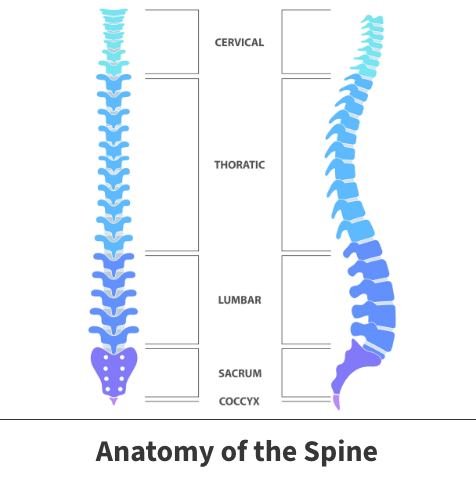Interlaminar lumbar instrumental fusion: ILIF
The spine is made up of many nerves and bones. When any of them become damaged, serious pain and movement issues can result. Injuries to the lumbar area can be especially concerning. Luckily, a treatment procedure called ILIF: Interlaminar Lumbar Instrumental Fusion can help.
Anatomy

The lower part of your spine is classified as the lumbar spine. This region comprises a collection of muscles, soft tissues, blood vessels, and nerves. Additionally, the lumbar spine consists of five bones known as vertebra. These bones protect the section of your spine known as the lamina.
The lamina and lower spine perform several essential functions such as:
- Enabling your back to move in different directions
- Protect surrounding nerves making up your spinal cord
- Controlling leg movements
- Supporting the upper body’s weight, especially the head and neck
- Additionally, the lumbar spine allows the body to place weight on your legs
About
When the lumbar vertebra weaken, many bothersome and potentially even serious symptoms can result. ILIF: Interlaminar Lumbar Instrumental Fusion can be performed to help alleviate them.
Causes of lumbar injuries
Several issues can cause the weakening of your lumbar vertebra. Common problems include:
- Age – As you age, the strength and structure of your vertebra tend to decrease.
- Trauma – Significant physical trauma caused by acute events like automobile accidents, falls, or strenuous physical contact can result in serious and immediate lumbar damage.
- Medical conditions – Sometimes, certain illnesses result in lumbar degeneration. One common cause is arthritis, which gradually destroys the discs contained inside the vertebra. Another common underlying problem is spondylolisthesis, which causes the discs contained inside vertebra to shift out of position and adversely impact surrounding structures.
If left untreated, lumbar damage could progress to the point where deformed or diseased vertebra can press against the surrounded spinal cord. In medical terms, this condition is known as spinal stenosis.
Symptoms
The symptoms you experience often depend on how severe your lumbar is injured or diseased. The most common occurrence you are likely to feel is lower back pain. This discomfort can worsen when you stand or exercise.
Additionally, you might encounter other problems, including:
- Discomfort that spreads to other body parts like your legs, buttocks, and thighs
- Acute cramping in the lower back, legs, and thighs
- Muscle weakness in your lower back and surrounding body parts
- Pain may lessen when you sit or bend down
- In moderate to severe cases, you may also experience tingling or numbness in your legs. These occurrences might significantly limit your ability to walk or perform basic tasks.

Diagnosis
Lower back pain and several other symptoms associated with lumbar degeneration and spinal stenosis are common to many other conditions. Your doctor will need to perform a thorough physical examination before confirming the condition. This assessment might start with your physician asking you questions such as:
- When did the pain begin?
- Where do you feel it most?
- Does the discomfort spread to other regions?
- Have you experienced any recent back trauma?
- If you have ever been diagnosed with any illnesses or physical injuries?
If your doctor thinks you might have lumbar issues or spinal stenosis, they might ask you to perform various movement tests to measure your pain threshold and range of motion.
Your doctor will often verify the diagnosis after viewing the results of imaging tests like X-Rays, an MRI (magnetic resonance imaging scans), or CT scan (computerized tomography) which capture internal images of your lower back and spine. Any damage or disease should be detectable after using these diagnostic tools.
Treatment
If your doctor concludes that your lumbar vertebra are severely ailing or injured, or that your symptoms significantly interfere with your life, the ILIF procedure might be indicated. ILIF is often favored by surgeons and patients alike because it is considered minimally invasive.
A surgeon begins this process by making an incision in your back directly over the location of the damaged vertebra.
Once the initial incision is made, the surgeon then removes materials located between the vertebra known as lamina and spinous process.
When this material is removed, bone grafts are created and inserted into the vacated spaces. This is designed to protect surrounding nerves and enable the bone fusion process to occur.
Metal implants are then inserted over grafted bones. This is done to speed up the process in which vertebra and grafted bones join together.
The surgeon completes the process by stitching and bandaging the incision site.
In most instances, you return home either the same or the following day. Unlike invasive spinal decompression surgeries, ILIF involves minimal blood loss, a quicker recovery time, less scarring, a reduced amount of post-surgical pain, and a far quicker return to your daily routine.
Videos
Related specialties
- Anterior Cervical Corpectomy & Discectomy
- Artificial Disc Replacement (ADR)
- Bone Cement Injection
- Degenerative Disc Disease
- Diffuse Idiopathic Skeletal Hyperostosis (DISH)
- Discectomy
- Discitis Treatment & Information
- Epidural Injections for Spinal Pain
- Foraminotomy
- Interlaminar Implants
- Kyphoplasty (Balloon Vertebroplasty)
- Kyphosis
- Laminectomy: Decompression Surgery
- Lumbar Epidural Steroid Injection
- Lumbar Interbody Fusion (IBF)
- Minimally Invasive Spine Surgery
- Outpatient Spine Surgery
- Pinched Nerve
- Piriformis Syndrome
- Sacroiliac Joint Pain
- Sciatica
- Scoliosis
- Spinal Fusion
- Spondylolisthesis & Spondylolysis
- Vertebroplasty
- Whiplash & Whiplash Associated Disorder (WAD)
